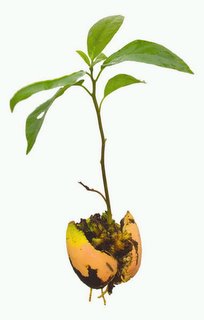 Friends and family share cuttings; you can also pick up a cutting on a nature walk or hike. Your own yard may have plants that can be harvested for additional landscaping. Whatever the source, a small leaf, stem, or root cutting can provide you new plants, for free. Gardeners call this "multiplying" your plants.
Friends and family share cuttings; you can also pick up a cutting on a nature walk or hike. Your own yard may have plants that can be harvested for additional landscaping. Whatever the source, a small leaf, stem, or root cutting can provide you new plants, for free. Gardeners call this "multiplying" your plants.Root
Choose a plant that is large and well-established. Pull up a piece of root, and cut it off, then cut it into three-inch pieces. (Each piece gives you a new plant.) Take
the piece, or "cutting," and put it into a little container of water or potting soil. Make sure it's completely covered with soil/water. Use some root starter (see below). The thick part of the cutting should be at the top, and the thinner portion at the bottom of the water/soil. If you've planted in soil, give it a good watering. Then, wait. Wait for months if need be -- little white roots will be forming in the soil that you can't see for awhile. Once you have a little plant, you're ready to move it to your pot or bed.
Leaf
This only works with some plants, but it's worth the experiment. For plants like African violets, you pull off a leaf along with about 1.5 inches of the leaf's stem. Put the stem end into water or potting soil. New plants will pop from the base of the stem. There will be more than one. If you're really into this, you can take these little new plants, pull off a leaf with stem from each of them, and build yourself quite a collection.
For plants like Aloe Vera, you don't have leaves with stems. Here, cut off a leaf, and then cut that leaf into 3 inch pieces. Put each piece vertically into the soil or water. Each piece, new plant.
Stem
This works for some trees. Cut off a twig from the current season's growth. Dip it into rooting solution, and then bury all but a third of the twig into good soil. Keep the soil warm (around 85 degrees) if you can. For hardwood trees, do this in winter. For softwood trees, do this with new, spring growth.
What is Rooting Solution?
Cuttings create their own roots faster if a rooting solution is used. IBA is the most popular one, and it comes as a powder, liquid, or gel. Don't use too much: you can "burn" your cutting with this stuff.
Source: NCStateUniversity; Auburn Dept. of Forestry; GardeningOrganic.Com; GlobalGarden.com.
3 comments:
Keep in mind that rooting hormone cannot be used on plants that are to be consumed. There is a wonderful alternative, but the name escapes me. If you are in the SA area, you can call Shades of Green and ask there. They carry it and it works equally, if not better, than the rooting hormone.
Hi,
A good homemade root starter would be of enormous use to houseplant lovers. Something natural and beneficial in getting the cutting off to a great start. Have any good recipes?
Soaking short pieces of willow tips will provide a good rooting "juice".
A couple of sites.
http://www.bluestem.ca/willow-article1.htm
And http://www.ehow.com/how_172766_make-rooting-tonic.html
Hope this is helpful.
What I am looking for is a recipe to make a rooting gel using Knox gelatin and adding something like the willow juice for the root stimulator and adding weak fert.
Post a Comment